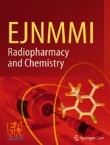Topical Collections about latest and interesting topics in EJNMMI Radiopharmacy and Chemistry are available at: https://link.springer.com/journal/41824/collections
Automated radiolabelling of [68Ga]Ga-PSMA-11 (gallium (68Ga)-gozetotide) using the Locametz® kit and two generators
Steps have been taken by pharmaceutical companies to obtain marketing authorisation of PSMA ligands in the European Union. Since December 2022, Locametz® (PSMA-11, gozetotide) is licensed as kit for manual rad...

